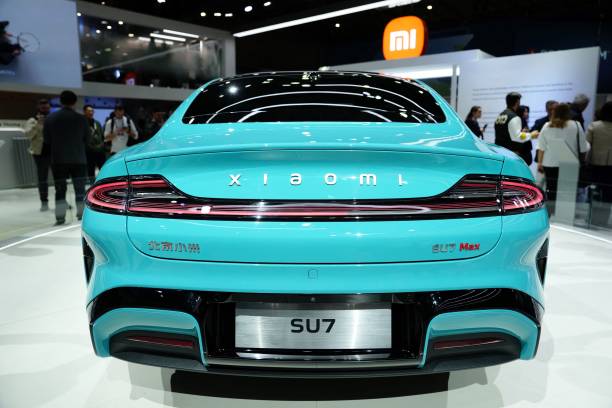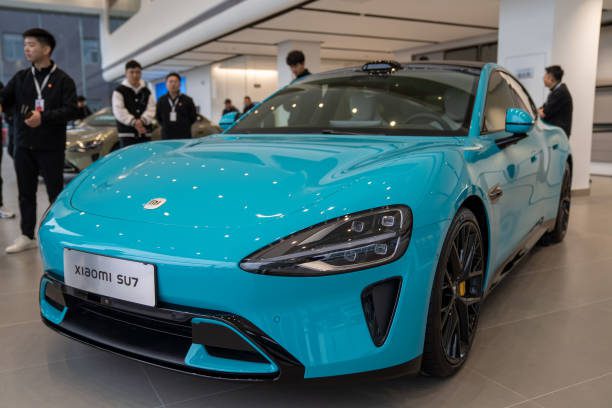On a day marked by anticipation and investor excitement, shares of Xiaomi, the Chinese electronics giant, leaped by up to 16% following the launch of its first electric vehicle, the SU7. The unveiling of this sporty car, which occurred last Thursday, has not only captivated interest but also significantly bolstered Xiaomi’s market valuation, even surpassing that of established American automakers like General Motors and Ford at certain points during the day.
Surging Stocks and Market Dynamics
The surge in Xiaomi’s stock price, which at its peak reached the highest level since January 2022, eventually settled to a 9% increase by the close of trading. This uptick added an impressive $4 billion to the company’s market value, culminating in a valuation of $55 billion, with the share price touching HK$17.34.
The SU7, affectionately termed Speed Ultra 7, introduces itself into the fiercely competitive Chinese electric vehicle (EV) market with a notably aggressive starting price of under $30,000 for the base model. This pricing strategy positions the Xiaomi SU7 as a more affordable option compared to Tesla’s Model 3 in China, signaling a bold entry into the segment.
Pricing and Market Strategy
Despite the challenges inherent in China’s EV landscape, characterized by a pricing battle and a slowdown in demand, Xiaomi’s venture into this territory is buoyed by its substantial financial resources and its expertise in smartphone technology. This technological prowess is particularly advantageous in the development of smart dashboards, a feature that holds considerable appeal among Chinese consumers.

Demand and Production Insights
The company has hinted at robust demand for the SU7, with advised wait times for potential buyers stretching between four to seven months. This was further evidenced by the announcement of 88,898 pre-orders within the first 24 hours of the vehicle’s sale.
Financial Forecasts and Market Responses
Xiaomi’s transition from a smartphone-centric revenue model, which accounted for the majority of its $37.5 billion in earnings, to embracing electric vehicles, is underscored by the production of 5,000 “Founder’s Edition” SU7 vehicles. These special edition models come equipped with additional accessories, catering to the early adopters of the brand’s EV initiative.
Future Implications and Market Evolution
Lei Jun, the founder and CEO of Xiaomi, took to social media to announce the commencement of deliveries from this inaugural batch, set to begin across 28 Chinese cities, marked by a ceremonial event at its Beijing factory. This launch represents the culmination of Lei’s vision, who in 2021, declared the company’s pivot to electric vehicles as his “last major entrepreneurship project.”
Despite the optimism, Xiaomi anticipates losses with the SU7, a sentiment echoed by market analysts. Citi Research, in a recent note, expressed a cautious stance on the profitability within the EV price segment Xiaomi is targeting, predicting a substantial financial hit for the company. They estimate an average loss of approximately $9,400.96 per car, factoring in a projected sales volume of 60,000 units for the year, translating into a net loss of around $566.82 million.

In response to the SU7’s market entry, competing Chinese EV brands have adjusted their strategies, implementing price reductions and subsidies. This development indicates a heating competition in the 200,000 to 300,000 yuan price bracket, which is expected to feature around 240 EV models by 2024, an increase of nearly 20% from the previous year. Amidst this burgeoning demand, Xiaomi has reportedly requested its suppliers to ramp up the SU7’s production capacity, signaling confidence in its market appeal.
Could Xiaomi’s Foray into Electric Vehicles Reshape the Market?
Understanding AARTO Infringement and Its Implications in South Africa
As Xiaomi carves out its niche in the electric vehicle domain with the launch of the SU7, questions arise about the long-term sustainability of its competitive pricing and the impact on the broader EV market. Will Xiaomi’s strategic entry prompt a reevaluation of pricing strategies among established and emerging players? And importantly, how will the company’s technological prowess in smart dashboards and other features influence consumer preferences and expectations in a market that is increasingly valuing innovation over tradition?



